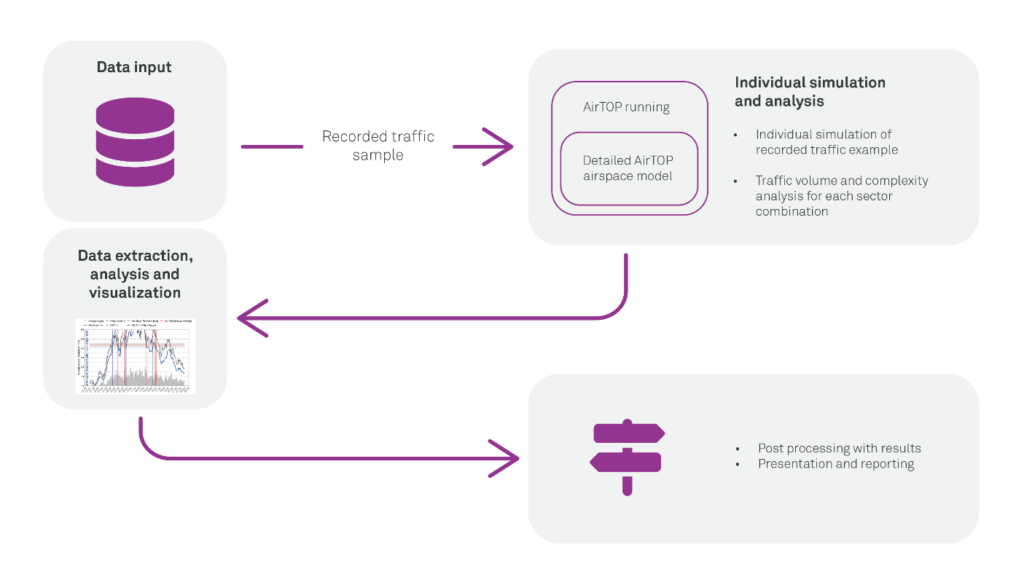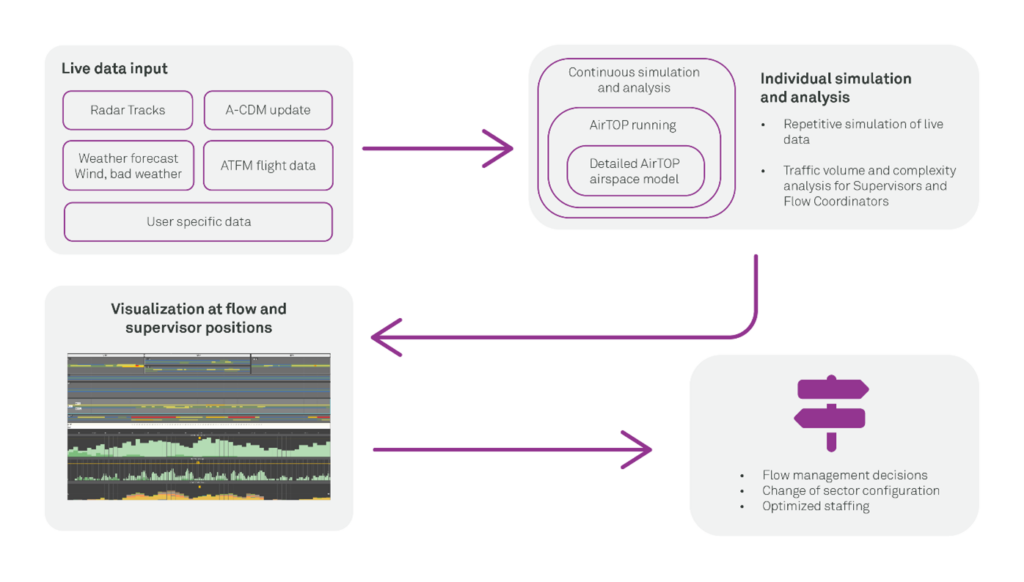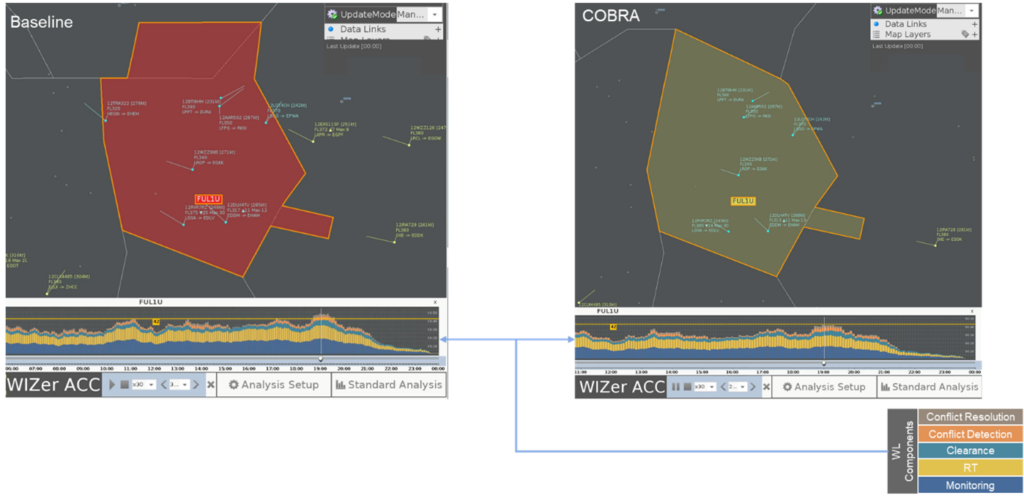Written by Alexander Gehres, DFS Deutsche Flugsicherung, in collaboration with Transoft Solutions
Fast-time simulation using live data sources
DFS Deutsche Flugsicherung GmbH, the German air navigation service provider (ANSP), is no stranger to conducting traditional fast-time simulations, having run well over 200 of them — both small and large — throughout the years.
DFS’s experience goes beyond traditional applications, however. Through their use of the AirTOP WIZer ACC tool, DFS has expanded their use of simulations — bringing them out of the simulator, into the control room and then back into the simulation environment. Achieving this has provided operational staff with a valuable tool for simulating and assessing live air traffic and flow management. Such a significant leap was made possible through collaborative efforts between DFS and Transoft Solutions, who worked together to make three essential modifications.
Fast-time simulation– the traditional way
In air traffic management (ATM), fast-time simulations have long been a trusted method for looking into the future and understanding how to respond to the revealed requirements.
Their fields of application are manifold. For airports, the focus is mostly on determining runway capacity. Simulations can be used to plan infrastructure projects or examine processes in the maneuvering area. For ANSPs, frequent changes to airspace structures to accommodate forecast traffic flows need to be investigated. The ATM environment also provides an equally diverse range of applications for fast-time simulations.
These types of traditional simulations have, for many years, been based on the same tried-and-tested approach (Figure 1). As a first step, the current infrastructure and procedures are mapped in a simulator, depending on the focus and the query to be investigated. This status quo is then connected to a real, recorded traffic sample from the past or to a forecast traffic sample. This provides a baseline for the simulation, which can be used to incorporate a wide range of changes. The simulation results, in turn, can then be compared with the baseline results and the achieved level of performance can be evaluated.

Figure 1: Schematic representation of the conduct of fast-time simulations, using the example of airspace simulations
DFS has been using fast-time simulations since the 1990s to regularly test and evaluate ideas for improvement at airports and in airspaces, carrying out hundreds of larger and smaller simulation projects using this procedure. In 2006, they began using AirTOP, the airport and airspace fast-time simulation software by Transoft Solutions. This was a game changer for both DFS and Transoft, and the use of AirTOP by DFS significantly contributed to the ongoing development of this comprehensive suite of tools to model, simulate and visualize airport and air traffic operations.
The leap to the control room
It was after 2010 that the first considerations were made about expanding the range of applications of fast-time simulations beyond their use as an offline medium for assessing airspace structures. The ability to perform complexity and capacity analyses based on a current airspace structure and a recorded traffic sample, in conjunction with an applied workload model, spawned the idea of using these online in air traffic and flow management. However, to provide supervisors and flow management staff with a fast-time simulation tool for their daily work, three essential requirements had to be met. First, the tried-and-tested approach using recorded traffic samples had to be replaced by live or forecast flight plan data. Secondly, the individual simulation runs had to take place continuously. Lastly, their results had to be constantly updated and displayed on an intuitive HMI (Human Machine Interface). This was the birth of WIZer ACC (Figure 2).

Figure 2: Schematic representation of how WIZer ACC works
AirTOP WIZer ACC integrates the AirTOP fast-time simulation engine and controls it to perform a continuous loop of air traffic simulations within the operational environment. It provides area control center supervisors, flow management positions (FMPs), traffic managers, airport operators, and others with a real-time decision support tool, allowing them to forecast and assess traffic complexity and controller workload based on the current real-time traffic demand. It also allows them to perform real-time what-if analyses to achieve efficient demand capacity balancing (DCB).
With WIZer and its ‘what-if analyzer,’ the input data for all simulations are the scenarios to be used in the current what-if analysis along with the state of the current traffic, which is the result of the compilation of all received input live data.
The output of each of the calculated simulations is a forecast of the current airspace configuration based on the latest known traffic demand, along with airspace configuration alternatives, such as multiple opening schemes, re-routing scenarios, regulations, etc., based on the same traffic demand.
The basic prerequisite for using WIZer ACC in an operational environment is a high-resolution simulation model. This model contains all relevant Air Traffic Control (ATC) sectors and sector configurations, a customized workload model and, for airports, the possible runway configurations.
In short, WIZer ACC provides an up-to-date simulation environment used in daily live operations that, calibrated accordingly, covers the airspace of a complete ACC. The results are displayed on an interface known as the standard analysis. This contains bar charts for the open sectors, which provide information on workload, flight movements (entry counts) and occupancy. As part of the analysis, sectors can be merged or separated as desired to test a sectorization matched to fit the expected traffic volume. These results are also directly available without a further simulation run. A second screen allows users to observe the development of traffic on a chart display, similar to the format used in AirTOP. This interface, known as MAP, also has the option of displaying the vertical profiles of individual aircraft, for example.

Figure 3: Representation of a vertical profile in WIZer ACC
Over the years, WIZer ACC has been continuously upgraded and the included data continuously expanded. In addition to forecast flight plan data, WIZer ACC processes meteorological data, sector opening schemes, military airspace booking information, airport collaborative decision making (A-CDM) data, and information on local military aircraft movements. The tool is now being used by numerous European ANSPs. DFS uses WIZer ACC at their branches for lower airspace in Bremen, Langen and Munich. This integration of the tool into the DFS landscape is called AirMagic, in reference to AirTOP.
Using WIZer ACC as a simulation platform
WIZer ACC was developed from the idea of performing fast-time simulations with live data. At the same time, the high-resolution simulation model and the evaluation or display options offered by the WIZer environment can also form the basis for traditional fast-time simulations to test and evaluate planning ideas. This can be illustrated by two examples.
As part of an airspace restructuring project, the airspace boundary between the upper area control centers in Maastricht and Karlsruhe was slated to be modified to accommodate current traffic needs. The boundary was complex due to its historical evolution and the many ‘balconies’ and ‘windows’ of the controlled sectors (Figure 4).

Figure 4: Simulation area for baseline scenario (Karlsruhe sectors yellow, Maastricht sectors blue)
The simulation project aimed to review the capacitive potential while considering:
- the reduction of complexity through simplification of the airspace structure.
- the increase in efficiency by reducing coordination effort.
- the increase in safety through clearly separated procedures and routing.
After setting up the baseline as a WIZer ACC simulation model, the current capacitive potential was simulated with different recorded, real traffic samples. For this purpose, all sector configurations to be investigated, including a controller workload scheme, were defined and mapped in advance. This process was repeated with the new airspace structure designed by operational experts.
So far, this approach does not differ from the traditional approach described earlier. However, the advantages offered by the WIZer ACC simulation environment lie in the subsequent evaluation of the simulation scenarios. In a traditional simulation, the evaluation takes place largely in the post-processing phase and often requires manual intervention or further work on the result files for the use of an analysis platform. Furthermore, different sector configurations (merged/separated sectors) each require their own simulation runs. This increases the effort required in creating the respective simulation scenarios, including the necessary separate evaluations. It is a laborious process with many repetitive steps, as even the smallest changes to the scenarios require new simulation runs with a subsequent evaluation process.
WIZer ACC, on the other hand, displays the results of a simulation run on an easy-to-grasp HMI. The results for all stored sector configurations are calculated at once and can be displayed directly. If baseline and future scenarios are simulated on different entities, the results can be viewed in parallel, and differences can be directly compared and analyzed. On the WIZer ACC MAP (Figure 5), the traffic flows can be viewed in the replay. The differences in the workload shown at the bottom of the two images are represented synchronously in time.

Figure 5: Baseline (left) and planning scenario (right) in parallel
Starting from the example described above, it is then only a small step to carry out simulation projects based on WIZer ACC with live data. For example, the DFS branch in Bremen uses WIZer ACC operationally (as AirMagic) in air traffic and flow management.
In the airspace to the east of Berlin Brandenburg Airport, the simultaneous processing of arrivals and departures often results in high-workload situations that must be solved through, for example, flow management measures and lead to delays. To counteract this, DFS developed an alternative airspace structure in which departures from the airport are now handed over to the neighboring air navigation service providers at lower altitudes, thereby reducing high-load situations (Figure 6).

Figure 6: Schematic representation of departures in the baseline and planning scenario
A copy of the existing WIZer ACC simulation model, supplemented by modifications, is made available as a second instance at an AirMagic station outside the control room and supplied with live data from the AirMagic system. The key step is that fast-time simulations consisting of baseline and future scenarios are now displayed in parallel, using daily updated traffic forecasts (live data). This allows operational planners and decision-makers to look at their ideas based on different traffic situations over a longer period of time, analyze them and modify them if necessary. Besides the speed of creating fast-time simulation live data, the biggest gain has been that the direct involvement of the clients significantly increases their confidence in the simulation results.
Conclusion
With WIZer ACC, fast-time simulators have made the leap into ANSP control rooms and can support operations staff in complexity and capacity analyses on a daily basis. The use of WIZer ACC outside of the operational environment as a basis for fast-time simulations offers just as many advantages and, in turn, increases performance.